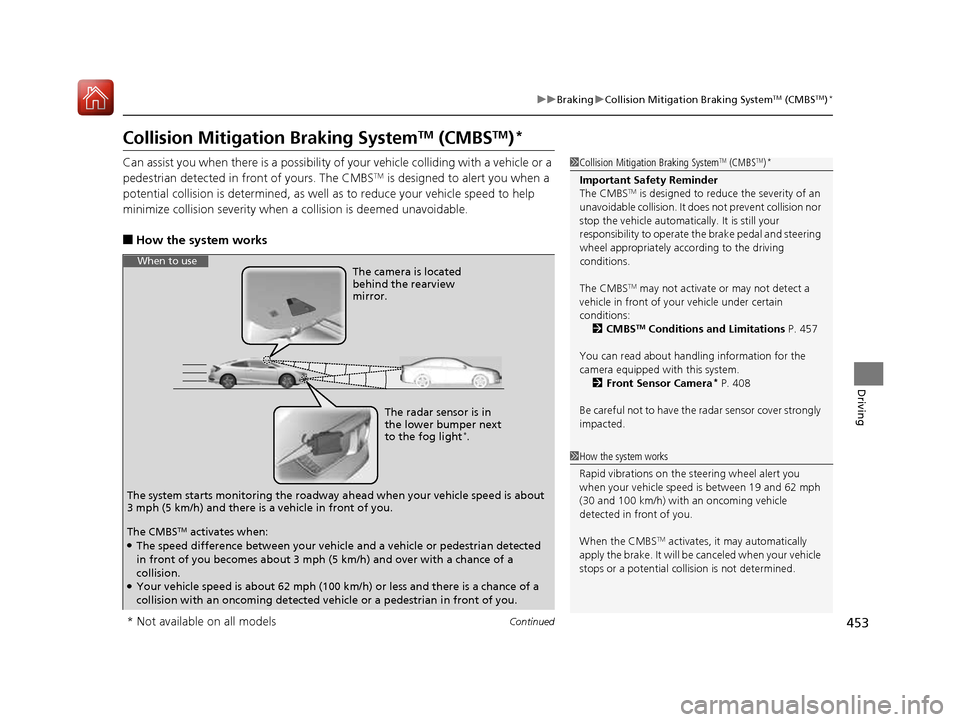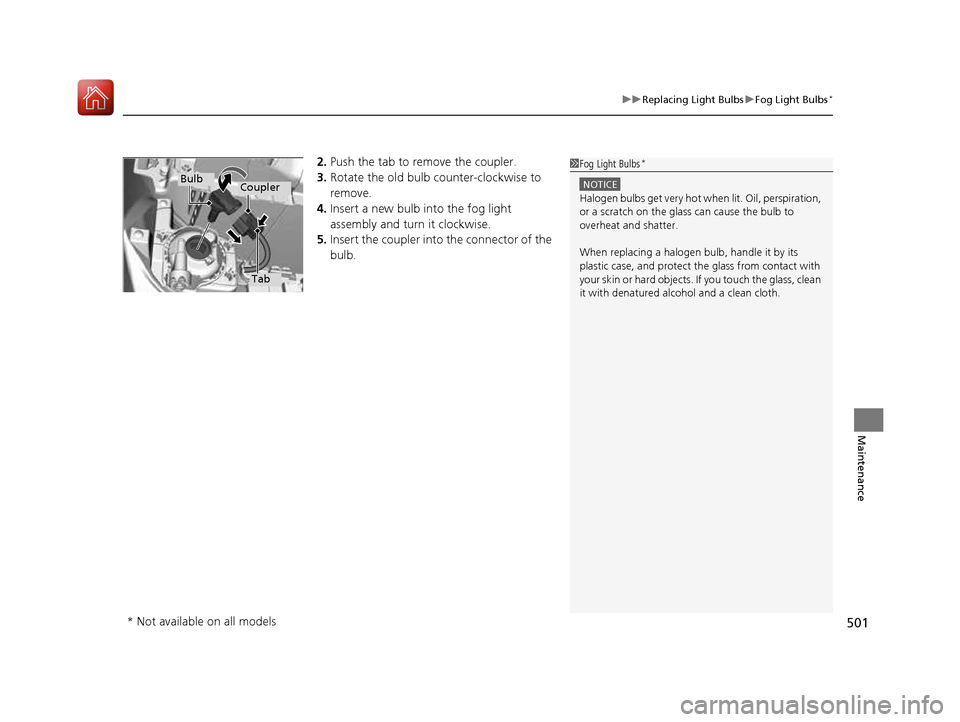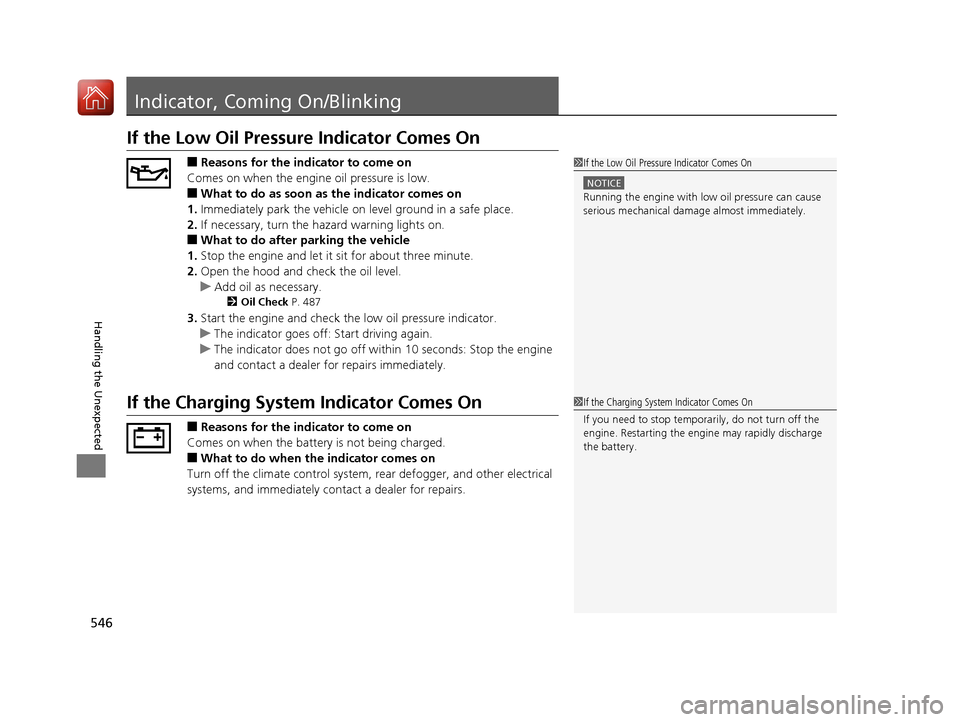2016 HONDA CIVIC COUPE fog light
[x] Cancel search: fog lightPage 435 of 585

434
uuWhen DrivinguLane Keeping Assist System (LKAS)*
Driving
■
Roadway conditions
• Driving on a snowy or wet roadway (obs cured lane marking, vehicle tracks,
reflected lights, road spray, high contrast).
• Driving on a road with temporary lane markings.
• Faint, multiple, or varied lane markings are visible on the roadway due to road
repairs or old lane markings.
• The roadway has merging, split, or crossing lines (e.g., such as at an intersection
or crosswalk).
• The lane markings are extremely narrow, wide, or changing.
• The vehicle in front of you is driving near the lane lines.
• The road is hilly or the vehicle is approaching the crest of a hill.
• Driving on rough or unpaved roads, or over bumpy surfaces.
• When objects on the road (curb, guard rail, pylons, etc.) are recognized as white
lines (or yellow lines).
• Driving on roads with double lines.
■ Vehicle conditions
• Headlight lenses are dirty or the headlights are not properly adjusted.
• The outside of the windshield is streake d or blocked by dirt, mud, leaves, wet
snow, etc.
• The inside of the windshield is fogged.
• The camera temperature gets too high.
• An abnormal tire or wheel condition (wrong size, varied size or construction,
improperly inflated, comp act spare tire, etc.).
• The vehicle is tilted due to a heav y load or suspension modifications.
16 CIVIC 2D HC2 (0A 01 0C)-31TBG6000.book 434 ページ >0>.>/6年>0月>/>0日 金曜日 午後4時>/6分
Page 454 of 585

453
uuBrakinguCollision Mitigation Braking SystemTM
(CMBS TM
)*
Continued
Driving
Collision Mitigation Braking System TM
(CMBS TM
)*
Can assist you when there is a possibility of your vehicle colliding with a vehicle or a
pedestrian detected in front of yours. The CMBS TM
is designed to alert you when a
potential collision is determined, as well as to reduce your vehicle speed to help
minimize collision severity when a collision is deemed unavoidable.
■ How the system works
1Collision Mitigation Braking System TM
(CMBS TM
)*
Important Safety Reminder
The CMBS TM
is designed to reduce the severity of an
unavoidable collision. It doe s not prevent collision nor
stop the vehicle automatically. It is still your
responsibility to operate the brake pedal and steering
wheel appropriately acco rding to the driving
conditions.
The CMBS TM
may not activate or may not detect a
vehicle in front of y our vehicle under certain
conditions:
2 CMBS TM
Conditions and Limitations P. 457
You can read about handling information for the
camera equipped with this system. 2 Front Sensor Camera *
P. 408
Be careful not to have the radar sensor cover strongly
impacted.
1How the system works
Rapid vibrations on the steering wheel alert you
when your vehicle speed is between 19 and 62 mph
(30 and 100 km/h) with an oncoming vehicle
detected in front of you.
When the CMBS TM
activates, it may automatically
apply the brake. It will be canceled when your vehicle
stops or a potential coll ision is not determined.
The radar sensor is in
the lower bumper next
to the fog light*
.
The camera is located
behind the rearview mirror.
The system starts monitoring the roadway ah ead when your vehicle speed is about
3 mph (5 km/h) and there is a vehicle in front of you.
When to use
The CMBS TM
activates when:
● The speed difference between your vehicle and a vehicle or pedestrian detected
in front of you becomes about 3 mph (5 km/h) and over with a chance of a
collision.
● Your vehicle speed is about 62 mph (100 km/h) or less and there is a chance of a
collision with an oncoming detected ve hicle or a pedestrian in front of you.
* Not available on all models
16 CIVIC 2D HC2 (0A 01 0C)-31TBG6000.book 453 ページ >0>.>/6年>0月>/>0日 金曜日 午後4時>/6分
Page 458 of 585

Continued457
uuBrakinguCollision Mitigation Braking SystemTM
(CMBS TM
)*
Driving
The system may automatically shut off and the CMBS TM
indicator will come on under
certain conditions. Some exam ples of these conditions are listed below. Other
conditions may reduce some of the CMBS TM
functions.
2 Front Sensor Camera *
P. 408
■ Environmental conditions
• Driving in bad weather (rain, fog, snow, etc.).
• Sudden changes in ambient light, such as an entrance or exit of a tunnel.
• There is little contrast between objects and the background.
• Driving into low sunlight (e.g., at dawn or dusk).
• Strong light is reflec ted onto the roadway.
• Driving in the shadows of trees, buildings, etc.
• Roadway objects or structures are misint erpreted as vehicles and pedestrians.
• Reflections on the interi or of the windshield.
■ Roadway conditions
• Driving on a snowy or wet roadway (obs cured lane marking, vehicle tracks,
reflected lights, road spray, high co ntrast on a snowy or wet roadway).
• Driving on curvy, winding, or undulating roads.
■CMBS TM
Conditions and Limitations1CMBS TM
Conditions and Limitations
Do not put a sticker on the radar sensor cover or
replace the radar sensor cover.
If you need the radar sensor to be repaired, or removed, or the radar se nsor cover is strongly
impacted, turn off the system by pressing the CMBS TM
off button and take your vehicle to a dealer.
* Not available on all models
16 CIVIC 2D HC2 (0A 01 0C)-31TBG6000.book 457 ページ >0>.>/6年>0月>/>0日 金曜日 午後4時>/6分
Page 459 of 585

458
uuBrakinguCollision Mitigation Braking SystemTM
(CMBS TM
)*
Driving
■
Vehicle conditions
• Headlight lenses are dirty or the headlights are not properly adjusted.
• The outside of the windshie ld is blocked by dirt, mud, leaves, wet snow, etc.
• The inside of the windshield is fogged.
• An abnormal tire or wheel condition (wrong size, varied size or construction,
improperly inflated, comp act spare tire, etc.).
• When tire chains are installed.
• The vehicle is tilted due to a heav y load or suspension modifications.
• The camera temperature gets too high.
• Driving with the parking brake applied.
• When the radar sensor in the lower bumper gets dirty.
■ Detection limitations
• A vehicle or pedestrian suddenly crosses in front of you.
• The distance between your vehicle and the vehicle or pedestrian ahead of you is
too short.
• A vehicle cuts in front of you at a slow speed, and it brakes suddenly.
• When you accelerate rapidly and approach the vehicle or pedestrian ahead of you
at high speed.
• The vehicle ahead of you is a motorcycle, bicycle, mobility scooter or other small
vehicle.
• When there are animals in front of your vehicle.
• When you drive on a curved, wi nding or undulating road that makes it difficult for
the sensor to properly detect a vehicle in front of you.
• The speed difference between your vehicle an d a vehicle or pedestrian in front of
you is significantly large.
• An oncoming vehicle suddenly comes in front of you.
• Another vehicle suddenly comes in front of you at an intersection, etc.
• Your vehicle abruptly crosses over in front of an oncoming vehicle.
• When driving through a narrow iron bridge.
• When the lead vehicle suddenly slows down.
16 CIVIC 2D HC2 (0A 01 0C)-31TBG6000.book 458 ページ >0>.>/6年>0月>/>0日 金曜日 午後4時>/6分
Page 501 of 585

500
uuReplacing Light BulbsuFog Light Bulbs*
Maintenance
Fog Light Bulbs *
When replacing, use the following bulbs.
1.Remove the clips using a flat-tip
screwdriver, remove the bolt, and push up
the under cover.
Fog Light: 35 W (H8 for halogen bulb type)
1Fog Light Bulbs *
Insert a flat-tip screwdriver, lift and remove the center pin to remove the clip.
Insert the clip with the center pin raised, and push
until it is flat.
Push until the pin
is flat.
* Not available on all models
16 CIVIC 2D HC2 (0A 01 0C)-31TBG6000.book 500 ページ >0>.>/6年>0月>/>0日 金曜日 午後4時>/6分
Page 502 of 585

501
uuReplacing Light BulbsuFog Light Bulbs*
Maintenance
2.
Push the tab to remove the coupler.
3. Rotate the old bulb counter-clockwise to remove.
4. Insert a new bulb into the fog light assembly and turn it clockwise.
5. Insert the coupler into the connector of the
bulb.1Fog Light Bulbs *
NOTICE
Halogen bulbs get very hot wh
en lit. Oil, perspiration,
or a scratch on the glass can cause the bulb to
overheat and shatter.
When replacing a halogen bulb, handle it by its
plastic case, and protect th e glass from contact with
your skin or hard objects. If you touch the glass, clean
it with denatured alc ohol and a clean cloth.
Tab
CouplerBulb
* Not available on all models
16 CIVIC 2D HC2 (0A 01 0C)-31TBG6000.book 501 ページ >0>.>/6年>0月>/>0日 金曜日 午後4時>/6分
Page 529 of 585

528
uuCleaninguExterior Care
Maintenance
The inside lenses of exterior lights (headlights, brake lights, etc.) may fog temporarily
if you have driven in the rain, or after the vehicle has been run through a car wash.
Dew condensation also may build up inside the lenses when there is a significant
enough difference between the ambient and inside-lens temperatures (similar to
vehicle windows fogging up in rainy conditions). These conditions are natural
processes, not structural design problems in the exterior lights.
Lens design characteristics may result in moisture developing on the lens frame
surfaces. This also is not a malfunction. However, if you see large amounts of water
accumulation, or large water drops building up inside the lenses, have your vehicle
inspected by a dealer.
■Fogged Exterior Light Lenses
16 CIVIC 2D HC2 (0A 01 0C)-31TBG6000.book 528 ページ >0>.>/6年>0月>/>0日 金曜日 午後4時>/6分
Page 547 of 585

546
Handling the Unexpected
Indicator, Coming On/Blinking
If the Low Oil Pressure Indicator Comes On■Reasons for the indicator to come on
Comes on when the engine oil pressure is low. ■ What to do as soon as the indicator comes on
1. Immediately park the vehicle on level ground in a safe place.
2. If necessary, turn the ha zard warning lights on.
■ What to do after parking the vehicle
1. Stop the engine and let it sit for about three minute.
2. Open the hood and check the oil level.
uAdd oil as necessary.
2 Oil Check P. 487
3. Start the engine and check th e low oil pressure indicator.
uThe indicator goes off: Start driving again.
uThe indicator does not go off within 10 seconds: Stop the engine
and contact a dealer for repairs immediately.
If the Charging System Indicator Comes On
■Reasons for the indicator to come on
Comes on when the battery is not being charged. ■ What to do when the indicator comes on
Turn off the climate con trol system, rear defogger, and other electrical
systems, and immediately contact a dealer for repairs.
1If the Low Oil Pressure Indicator Comes On
NOTICE
Running the engine with low oil pressure can cause
serious mechanical damage almost immediately.
1If the Charging System Indicator Comes On If you need to stop temporarily, do not turn off the
engine. Restarting the engi ne may rapidly discharge
the battery.
16 CIVIC 2D HC2 (0A 01 0C)-31TBG6000.book 546 ページ >0>.>/6年>0月>/>0日 金曜日 午後4時>/6分